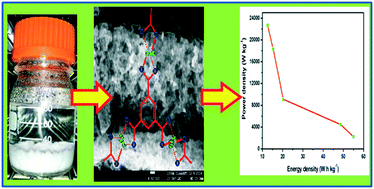MOF-derived microstructural interconnected network porous Mn2O3/C as negative electrode material for asymmetric supercapacitor device†
Abstract
A metal–organic framework is employed for the preparation of an interconnected network porous structure of Mn2O3/carbon for supercapacitor applications. X-ray diffraction patterns indicate the crystal structure of the Mn2O3/carbon composites. Morphological studies reveal the formation of a carbon interconnected network porous structure of the prepared samples. X-ray photoelectron spectroscopy and energy-dispersive X-ray analysis confirm the carbon coating on the Mn2O3 particles. Three-electrode measurements showed that the prepared Mn2O3/C composite is suitable for asymmetric supercapacitor device fabrication, since the negative electrode exhibits a highest specific capacitance of 776 F g−1 at a specific current of 1 A g−1. The symmetric device yields a specific cell capacitance of 122 F g−1 at a specific current of 2.5 A g−1. The asymmetric device yields a maximum specific energy capacity of 54.9 W h kg−1 at a power capacity of 2245 W kg−1.



 Please wait while we load your content...
Please wait while we load your content...